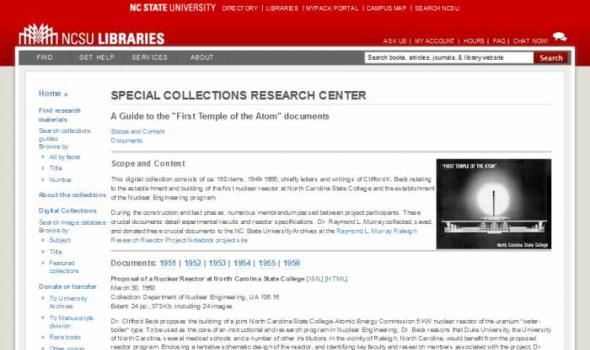Category: Chemistry, Text
Results
“I have no Knowledge of it at all,” wrote Ezra Stiles of alchemy. “I never saw Transmutation, the aurific Powder, nor the Philosophers Stone,” the early President of Yale College continued, “nor did I ever converse with an Adept knowing him to be such. ...
This digital collection consists of ca. 150 items, 1949-1956, chiefly letters and writings of Clifford K. Beck relating to the establishment and building of the first nuclear reactor at North Carolina State College and the establishment of the Nuclear Engineering program.
During the construction and test phases, numerous memorandum passed between project participants. These crucial documents detail experimental results and reactor specifications. Dr. Raymond L. Murray collected, saved, and donated these crucial documents to the NC State University Archives at the Raymond L. Murray Raleigh Research Reactor Project Notebook project site.
Introduction In 1999, inspired by the remarkable success of the Human Genome Project, the OSU Libraries Special Collections launched an ambitious undertaking that seeks to closely-document virtually every day of Linus and Ava Helen Pauling's lives. The result is Linus Pauling Day-by-Day, a constantly-expanding resource that provides in-depth description for a substantial portion of the half-million item Ava Helen and Linus Pauling Papers. This huge amount of data is presented in easy-to-use calendar form. Index pages created for each year of the Day-by-Day calendar provide an overview of the major events in the Paulings' lives, a full accounting of their travel and snapshots from their various adventures at home and abroad.
Linus Pauling, an OSU alum (Oregon Agricultural College, class of 1922), was among the most decorated of American scientists. He received his first honorary doctorate from his alma mater in 1933, and in rapid succession was similarly honored by institutions including Oxford University, the University of Chicago, Princeton University, Cambridge University and the Sorbonne. By the time of his death, Pauling had been awarded forty-seven honorary doctorates. Not included in this total is the honorary diploma received in 1962 from Washington High School in Portland, Oregon.
Linus Pauling and The Nature of the Chemical Bond: A Documentary History is comprised of three large sub-sections, each of which tells the story of the elucidation of chemical bond theory in a different way. Navigation between sub-sections may be achieved either through use of the links provided on the site homepage or through use of the links located in the header of each page within the site. Narrative - The first section - a forty-nine "chapter" Narrative - recounts the early years of chemical bond investigation primarily focusing on chemist Linus Pauling’s (1901-1994) research, which he later proclaimed as being his most important contribution to science.
History of Medicine Introduction This exhibit [and accompanying brochure] highlight the joint observance of the 500th anniversary of the birth of Paracelsus by three American medical libraries -- The Hahnemann University Library, The National Library of Medicine, and The Washington University Medical Library (St. Louis). It has been prepared to accompany the special exhibits which, along with lectures and other programs, are being organized at these libraries. The intent of the various events is to celebrate as well as to explain the contributions of this major Renaissance figure, especially those in medicine, chemistry, and pharmacy.
Philosophy of the Journal In a climate of high subscription charges often levied by commercial publishers and learned societies alike, ARKIVOC was launched in 2000 as a journal with a very different philosophy: it was designed for universal on-demand distribution at no cost to authors (no page charges or other fees), or readers (no access or downloading charges). Many of the standard publishing procedures are used in ARKIVOC, but a major difference is that the "Control Board" which runs the journal is unpaid. ARKIVOC also has a very large Editorial Board of Referees, currently with close to 1,000 members. ARKIVOC is unique from most such boards in that about half our members come from outside Western Europe, North America and Japan.
From Alchemy to Chemistry: Five Hundred Years of Rare and Interesting Books This website grew out of an exhibit held at the University of Illinois at Urbana-Champaign Rare Book Room in April 2000. The Eastern Illinois Section of the American Chemical Society provided support for the construction of this website. The exhibit, "From Alchemy to Chemistry: 500 Years of Rare and Interesting Books," was co-curated by Tina Chrzastowski (Chemistry Librarian), Vera Mainz (Director, VOICE NMR Lab, School of Chemical Sciences), and Gregory Girolami (Professor of Chemistry).
Isaac Newton, like Albert Einstein, is a quintessential symbol of the human intellect and its ability to decode the secrets of nature. Newton's fundamental contributions to science include the quantification of gravitational attraction, the discovery that white light is actually a mixture of immutable spectral colors, and the formulation of the calculus. Yet there is another, more mysterious side to Newton that is imperfectly known, a realm of activity that spanned some thirty years of his life, although he kept it largely hidden from his contemporaries and colleagues.



















